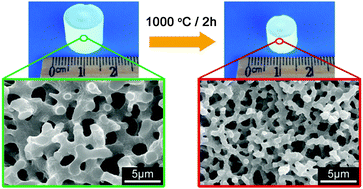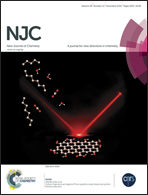Facile synthesis of monolithic mayenite with well-defined macropores via an epoxide-mediated sol–gel process accompanied by phase separation
Abstract
Monolithic mayenite with well-defined macropores has been successfully synthesized from ionic precursors via a sol–gel process accompanied by phase separation. The addition of propylene oxide (PO) to the starting solution leads to homogenous gelation and modifies the gel skeleton, whereas the addition of poly(ethylene oxide) (PEO) induces phase separation. Glycol acts as a chelating agent to suppress the precipitation of Ca2+ ions, and formamide works as a drying control chemical additive to enhance the drying behavior. Appropriate amounts of solvents, PEO, and PO allow the formation of calcium aluminate gels with co-continuous macroporous structure. The reaction mechanism of the sol–gel process of the Ca–Al–O system is also investigated by TG-DSC, FT-IR and NMR. The dried gels are amorphous and the crystalline phase Ca12Al14O32Cl2 forms after heat-treatment at 1000 °C in air, while the macroporous structure is preserved. The resultant monoliths before and after heat-treatment possess both high porosity and smooth and dense skeletons.


 Please wait while we load your content...
Please wait while we load your content...